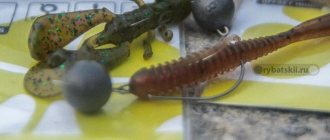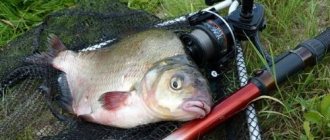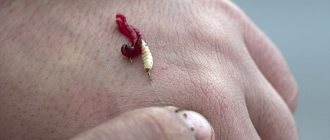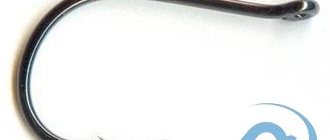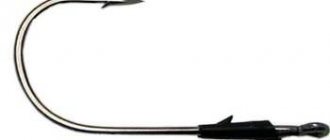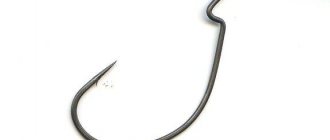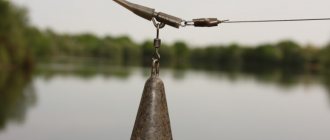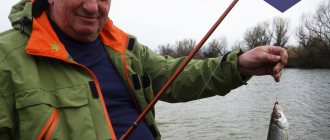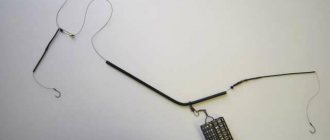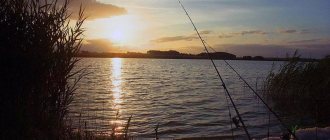Introduction to the topic
In any type of fishing, it is the hook that receives the most blame and criticism when the fish disappear or there is no bite. Either it turns out that it is too big and scares away the fish, or it is too small and is not capable of holding, for example, a bunch of worms. The hook may become bent when fishing for fish, it may simply tear the fish’s lip, or, as most often happens, it turns out to be blunt.
Let's ignore the manufacturer and the quality of the wire for now, and ask the question: what should the hook for the feeder be like? How does feeder differ from non-feeder? Should it be round? With a spatula or a ring? Should it have a curved tip? And where to? To the side or inward?... – Not only the feeder, but also any other fisherman has the right to ask these questions.
And the rule here is this: feeder hook , like any other, is first of all selected in accordance with the attachment or bait that we are going to fish with.
If we are catching dung worms with a bunch of dung worms, then the hook should be convenient to attach them (for example, No. 6-10 according to the European numbering), for bloodworms the thickness of the wire plays an important role, and in the case when we are fishing with dough or porridge, you can use hooks with a spiral for better retention of the nozzle. It turns out that the special hook for the feeder is the one that is tied to the feeder tackle.
If the packaging says that the hooks are designed specifically for feeder, this does not mean that it is necessary to use them specifically for feeder fishing. And this inscription does not mean that they are not suitable for fishing with boilies or springs.
You need to choose high-quality products and those that are suitable for specific fishing. And this is the correspondence of the hooks to the bait or bait used and the correspondence to the intended fish. The bait should correspond to the taste preferences of this same supposed fish.
And then there are more subtle, but no less important selection criteria:
- company manufacturer,
- form,
- wire thickness,
- color,
- length of the forend and so on, and this is a matter of practice and personal preference of the fisherman.
It must be remembered that the small size in combination with a thin leader line increases the number of bites. The greater the fishing pressure on a body of water, the more relevant this rule is.
And yet, out of all the variety of hooks offered, there are models that are most popular for feeder fishing. Our experience and communication with brothers in feeder fishing allowed us to make a selection of the most popular feeder hooks from leading manufacturers Owner, Kamasan, Gamakatsu and Mustad.
Of course, these are not all models that are used for feeder fishing. The authors of the site feederist.ru give only general recommendations on the choice of certain gear. Nevertheless, I hope that this review, like others, will help novice anglers with the choice of feeder gear. Will be able to provide at least some orientation and awareness of the products offered by stores.
Crocheters
For knitting feeder leashes, special loopers or hookers are used, which simplify and speed up the process of knitting leashes. And if you can still tie a large feeder hook by hand, then it is very difficult to tie small hooks of numbers 16–20 without additional equipment.
Considering that the smallest hooks are used in feeder fishing, it is clear that the presence of a hook in the box with accessories is mandatory. This is if, of course, you seriously decide to take up the feeder, although beginners should learn how to knit delicate rigs and rigs.
It’s not difficult to learn how to crochet using a special device, and there are many educational videos on this topic on the Internet. In addition to purchasing factory models of crocheters, it is possible to make a similar product yourself, especially since it is not difficult.
The use of hookworm is justified:
- when knitting small hooks;
- when using a thin leader line;
- with loss of visual acuity;
- when knitting a large number of leashes;
- while fishing in difficult weather conditions.
Each fisherman makes his own decision about using a hook, but there is no doubt that this device provides great assistance.
Important! When knitting a leash with hooks with a spatula, pay attention to the fact that the line goes towards the sting, otherwise the risk of breakage during fishing increases.
Feeder hooks from Owner
If we talk about good hooks, then the company Owner . Ovner company will also be mentioned first .
This manufacturer has become the de facto standard of sharpness and reliability. For about 50 years, the Japanese company Owner has been producing not only hooks, but also fasteners, swivels, lines, wobblers and other fishing accessories. Ovner even has his own patented sharpening method.
The range of products offered is simply huge: from the tiniest to super-reliable shark hooks. Only in our stores, not to mention markets, it is not always possible to choose from this entire assortment. But the most popular and beloved series by many are most often on sale in fishing stores in large cities, and even more so on various marketplaces.
As for the provinces, the choice here is very modest. It happens that it is not possible to find not only the desired model of feeder hooks, but even models from Owner in general.
The problem of counterfeit products is acute for Ovner. Popularity, considerable price, and the desire of the fisherman to try the “sharpest and most reliable” hook from a well-known brand – these are the incentives for scammers. And as a result, we often hear reviews from disappointed fishermen about the poor quality of products from this brand.
Trusted fishing stores, ordering online from popular foreign online stores - this is what can help fishermen make the right purchase. Well, or simply switch to other brands that are less counterfeited.
Which models from Owner choose for the feeder
We list the running series in ascending order of series number:
Owner series 50001
Thin hooks with a spatula, blue. Ovner positions them as suitable for fishing with “tinka” (greens). They are often used for feeders. The attachment can be a dung worm, a crawler, or grains. In short, everything that matches the number and the fish. The thin wire on this series makes it possible to use them for catching not very large fish.
Owner series 50152
The same model already has a ring, and the ring is bent inward. They have a short forearm. They are more suitable for feeder fishing with maggot, pearl barley, corn, hominy and other similar baits.
Owner series 50188
Excellent fishing hooks with a ring. Used by many fishermen both on a float and for bottom tackle. You can attach various plant and animal baits to them.
Owner series 50282, 50286
Very popular for feeders, similar two series of hooks with a spatula. No. 14 is one of my most popular hooks. Although I don’t like to be too detail-oriented with numbers (may our sporting gurus forgive me), for bloodworms there is nothing better for me. Although, again, you can use the nozzle at your discretion. The hooks of this series are reliable and hold the fish well when playing.
Owner series 50340
Model with a spatula. Available in three types of coatings: Black Chrome, Gold or Oxidize Gold. For feeder fishing, numbers 10-12 are mainly used. Almost any attachment that will correspond to the hook number.
Owner series 50344
Hooks are very popular for feeder. The tip is bent and specially processed using the “forged prying” method. Identical series 50342, 50343, 50345 differ in coating. Popular No. 12-18. The bait can be anything. Excellent, durable hooks, they can be safely recommended for use.
Owner series 50354; 50363
The manufacturer recommends them for winter fishing. But our fishermen successfully use them for bottom fishing on a feeder. Good hooks with a spatula and a round bend.
Owner series 50457
As you can see from the form, this is a model for using the worm. She has proven herself to be excellent.
Owner series 50922
Popular series with a ring. They have a slightly beveled rounded bend and a ring. Nozzle – almost any.
Owner series 50921, No. 10-14
Another great series with a ring. They are better suited when using a worm, but you can also fish with other baits.
Owner series 53100
Excellent universal hooks with an extended shank, round bend and blade. My running number for feeder is No. 12. The nozzle can be very different.
Owner series 53157
Brownish, unusual shape. The short hook and beveled bend give this hook the ability to hold a variety of baits. Popular #10-12. Worm, maggot, corn, pearl barley - in short, everything that our fish might like.
Here is a rather large selection of feeder hooks from Owner. It may seem like an advertisement, but what can you do, you can’t hide popularity. Although, in recent years it has become increasingly difficult to find a real Ovner, and other manufacturers offer models that are not at all worse. So let’s turn our fishing gaze to the remaining three manufacturers.
Examples of gear used: self-cutting fishing hooks
Roller-type equipment for pike fishing
Despite the fact that self-cutting hooks are more common when catching peaceful fish of the carp family, an example can be given of how to use them when catching a predator, such as pike, perch, pike perch or burbot. For this purpose, a “skating rink” type tackle is used.
The design of this fishing tool is simple and consists of the following elements:
- float-cylinder made of hard foam 18 cm in length and 6 cm in diameter and a cut for fastening the fishing line in the end part;
- fishing line of the required length, wound in the center of the float;
- olive shaped sinker;
- retractable leashes on carabiners, equipped with self-locking hooks.
The principle of fishing with such gear is similar to fishing with mugs, but has the advantage that it works even in windy weather. The sinker creates enough tension so that with a sharp jerk the predator sits on the hook. After fishing, the leash with the fish is unfastened from the main fishing line, replaced with a new one, and fishing continues.
Feeder self-cutting tackle
There are three options for using self-cutting tackle together with a feeder, although they are only suitable for reservoirs with standing water.
First option. It is the most popular and is actually a paternoster equipped with a short leash, the difference being the sinker, which changes to a weighted swim feeder. In this design, the fishing gear works very effectively when hunting roach, practically eliminating empty bites. The length of the leash is about half a meter, and the weight of the feeder is 50 grams; it is filled with animal bait. After casting, the line is tightened and a heavy bite alarm is installed.
Second option. Unlike the first option, this equipment consists of more elements:
- main line with a size 18 feeder attached to it;
- a leash with a self-closing hook is fastened from the feeder at a distance of half a meter;
- at the very end of the tackle a bombard weighing 50 grams is installed.
It is important to remember that with such heavy equipment, hooking is not only not required, but is generally dangerous, since it can lead to breakage of the working line. Hooking and fishing are done smoothly and slowly, slightly reeling in the line
Since the feeders have a considerable mass, to cast them, the tensile strength of the fishing line must be at least 3 kg. To protect the working leash with a strength of 1 kg, a spacer made of durable elastic material is used, which acts as a shock absorber.
Third option. This option is justified when fishing for carp. A large feeder feeder is attached to the end of the main line, and a self-cutting fishing hook is mounted just above it, on a very short leash.
The fishing technique is to fill the feeder with bait until a dense ball is formed. A hook is inserted into this ball, on which bait is pre-attached and camouflaged. The careful fish does not notice the line of the leash and begins to eat the bait with appetite, among which bait with a hook appears unnoticed. When the fish senses danger and suddenly swims to the side, it will hook itself. Using this method, the largest and most cautious carp are caught.
Do-it-yourself self-cutting tackle
- It is necessary to prepare diverting leashes with special hooks, a weight or feeder with a mass calculated from the mass of the expected fish caught, as well as accessories in the form of swivels, carabiners, shock absorbers and beads.
- The next step is to tie the swivel to the leash, and attach it to the main fishing line using a link from a carabiner with a bead and a shock-absorbing cambric.
- At the last stage, it is necessary to tie a feeder or a weight corresponding to the type of fishing to the end of the fishing line.
It should also be remembered that it is always necessary to adjust the drag on the reel if there is a lot of hiding place for fish in the reservoir. The rod must always be visible and within reach in order to exercise control over it. It is advisable to place it in your hand or a special holder, otherwise a large individual may drag it into the water with it, since a fish caught on a self-sustaining hook will no longer be able to get off it.
Feeder hooks from Kamasan
Another Japanese manufacturer of quality fishing hooks is Kamasan . For feeders, Kamasan hooks may be even more popular than Owner. Recommendations from well-known feeder experts could not but affect the choice of models from Kamasan. There are only a few popular series, but they more than cover all the needs for feeder fishing.
Kamasan B525 series
Reliable, hooky model with a ring. The manufacturer positions them as float rods, but as practice shows, they are also excellent for bottom fishing with a feeder. They are also universal in relation to bait.
Kamasan B532 series
Red hooks with a spatula. Made from thin wire. Excellent for worms and bloodworms. They are quite suitable for feeder fishing. You can catch white fish and carp.
Kamasan B651 series
Reliable for feeder fishing. They have a round shape, a small fore-end and a blade. Can be used for various attachments.
Kamasan B980 series
Some of my favorite hooks. Numbers 4-6 can be used on carp. Smaller size for crucian and white fish. The considerable diameter of the wire gives increased strength. Suitable for attaching a bunch of worms and various grains. I recommend.
Kamasan B983 series
Also a very popular series. Curved tip and short fore-end. Universal for different attachments, they fit perfectly into equipment. I use numbers from 4 to 16.
Leashes for feeder
Before each fishing trip, you should make sure that the leash has leashes with different hooks and different lengths. The consumption of leashes when fishing on a feeder is high, and if the leash is half empty, this can cause disappointment already during fishing, when the necessary leash with a certain hook is not at hand.
Naturally, they also knit leashes when fishing, on the shore of a pond, but doing this in inclement weather is inconvenient, so it’s better to have a reserve. The thinner the fishing line on which the leash is tied, the less noticeable it is to the fish, but the strength of the thin fishing line is significantly lower. It turns out that in pursuit of additional camouflage, the angler is faced with the problem of breaking leads.
It can be solved with the help of a reserve prepared in advance. At home, in a comfortable environment, the required number of leashes is knitted and no problems arise when fishing. The leashes for the feeder are larger than carp gadgets, since the length of the leashes varies from 10 cm to two meters and it is necessary to ensure their safety.
Feeder leashes are made of plastic, plastic or wood and their dimensions allow you to store leashes of any length. By the way, wooden leashes for feeder fishing are made to order, and sometimes they are real works of art.
Important! A feeder leash does not have to be expensive. The main thing is that leashes of the required length and in the required quantities fit into it.
Criterias of choice
When choosing leashes for your feeder, consider the following criteria:
- the size of the expected trophies;
- the presence of a current in a body of water;
- type of installation used;
- is there a shell and grass at the bottom;
- biting activity;
- features of fish behavior.
Feeder gear is good because the bait in the feeder serves as an attractive factor for fish and therefore it is desirable that the hook with the nozzle be in close proximity to it.
When fishing in still water, short leashes are chosen so that the bait is located next to the pile of pleasant-smelling bait. And it’s inconvenient to fish with a leash that is too long; it gets tangled when casting and creates a lot of inconvenience for the angler. That is, when fishing in stakes or lakes, short leashes for the feeder, 20–40 cm long, are preferable.
The leash for the feeder when fishing in the current has features related to the fact that the bait is carried downstream, and the hook with the nozzle is also carried away by the water flow. In order for the bait on the hook to be located in the train of bait carried by the current, the leash is made longer and sometimes reaches 2 meters.
This does not mean that you should immediately start fishing with super-long leashes, but in the absence of a bite, lengthening them sometimes brings the desired results.
Don’t forget that when fishing on a difficult, rocky bottom, a long leash is at great risk of being cut off by shells or stones. So before you decide to increase, really evaluate the existing fishing conditions. The leashes are also lengthened in case of inactive biting when fishing in cold water, on a weak current for small fish such as roach or bluegill.
After casting the equipment, the bait on a long leash slowly sinks to the bottom and this attracts a curious fish. Before biting, she doesn’t even have time to really look at the bait and feel the catch, especially since there is competition from other hungry fish, and it’s important not to give up the prey.
There is no denying that anglers have their own thoughts and preferences regarding the choice of leash length, confirmed by extensive experience. So, only beginner feeders who do not have much practical experience in fishing in different conditions should recommend this or that leash length.
The lack of long leashes also manifests itself in unnoticeable bites, as well as poor hooking of the fish by the lip when biting. The reasons are objective and in order to react in time and change the value, you should pay attention to how the trophy is detected.
Thin and long leashes are short-lived, so stocking them up is done first; everything will come in handy when fishing. Moreover, a long leash can easily be made into a short one, but the reverse is impossible.
Unfortunately, there are often situations when a fish swallows a hook with a nozzle too deeply, and the angler must have an extractor to remove the hook from its body. Such an extractor is attached to a cord and hung around the neck, so as not to interfere with fishing and always be at hand.
Important! It is better to start fishing with leashes with a length of 20 mm and gradually increase the length in increments of 10 mm, if necessary.
Leash thickness
When catching cautious fish on a feeder, and most often this is the case, for knitting leashes, inconspicuous fishing lines are chosen, or rather, even monofilament leash materials. This line is relatively transparent and has a thickness of 0.08 mm.
The thinner the diameter of the leader material, the more invisible it is in the water. But a small diameter does not guarantee the strength of the equipment and fish runs and breakages of leashes made from thin fishing line cannot be avoided. Therefore, a reasonable ratio of the thickness and strength of the leader material is selected, which allows you to catch fish, and not think about where to get another leader instead of the one that broke.
When fishing with thin leashes, feeder rubber (feedergum) also helps out, compensating for the extra force when the fish jerks while playing. The feedergam insert lengthens the leash, which is taken into account when determining its length.
Most well-known line manufacturers offer monofilament leader materials in diameters that provide comfortable fishing with feeder gear. Their cost is not that high, so it is better to purchase several options in order to be fully equipped when fishing. Memoryless monofilament leader line with a good ratio of diameter and strength, supplied in unwinds of 25–50 meters.
Fluorocarbon feeder leads
A breakthrough in the fishing market was the appearance of fluorocarbon, a fluorocarbon fishing line that is invisible even in clear water.
The obvious advantages of this material are:
- invisibility in clear water;
- abrasion resistance;
- lack of memory.
But the disadvantages of fluorocarbon fishing line, compared to monofilament, cannot be overlooked:
- higher cost;
- lower tensile strength with equal diameter.
The rigidity of such a fishing line is also not always an advantage. So you have to think carefully before deciding whether it is worth changing the usual monofilament to the already familiar fluorocarbon.
The price of fluorocarbon fishing line is gradually decreasing, and the quality is also improving, and this primarily applies to thin fishing lines of small diameter. So now many fans of English donkey are switching to fluorocarbon leader materials in order to increase the weight of their catches.
Leashes for flat method feeder
The specifics of catching fish using the flat flat feeder method affects the choice of leader materials, as well as the length of the leaders used. For proper operation of the installation, a soft leader material is required, and given the fact that trophy fish are caught on the flat, monofilament fishing line is not the best option.
In principle, no one forbids fishing with leashes made of monofilament fishing line, but they do not fully cope with their assigned functions.
The same goes for fluorocarbon fishing line, which is also tough. When fishing for small carp at short distances, some anglers use leashes made of monofilament fishing line, but this is the exception rather than the rule.
To knit the correct leash using the flat feeder method, a soft braided leash material with a breaking load of 10-20Lb is selected. The leash length is 8-12 mm and this is enough to cover all possible fishing conditions.
Beginning fans of feeder fishing should be aware that the overall success of the fishing session depends on the quality of installation and the correct choice of leash. Even if you have to experiment with the length or thickness of the leads, this should not interfere with achieving your goal, which is a decent catch. Experienced bottom fishermen use several different but effective knots for knitting leashes. This allows them to always be confident that the equipment will not fail even in the most difficult moments.
Feeder hooks from Gamakatsu
So, we come to the third Japanese manufacturer of fishing hooks, Gamakatsu. It just so happened that Japanese wire has become one of the standards for quality fishing gear. The history of the company goes back more than 55 years. During this time, the company has undergone enormous development: from hand-made fishing hooks to several modern factories for the production of various fishing accessories (spinning rods, clothing, regular and special feeder lines, etc.). In the European market, Gamakatsu also operates under the Spro brand.
Many models of hooks from Gamakatsu are perfectly suited for feeders. Reasonable price and excellent quality attracts many fishermen. For feeder fishing I mainly use:
Gamakatsu LS-1010B series
Very hooky hooks with minimal shedding. In my opinion, they have the optimal wire thickness. You can hang maggots, various grains and bloodworms on them. This series has a spatula and a brownish finish.
Gamakatsu LS-1040R series
A catchable series with an elongated fore-end, a spatula and a reddish tint. I use numbers 12 to 16 mainly for bream and crucian carp.
Gamakatsu 3510F series
Like the previous two series, it is very popular for feeder fishing. Short fore-end and slightly curved tip. Universal for various attachments. The most popular are No. 8-12.
Gamakatsu LS 3524F and F22 series
Perhaps one of the most successful episodes. The unusual shape and thin wire make them self-hinging. Most often I use No. 8-16. They are excellent for catching silver bream, crucian carp, carp, bream, and roach with feeder gear. It is very good to use pearl barley grains on them. I usually plant (depending on the number) 2-5 pieces. The shape facilitates good swallowing of this bait by the fish. You can successfully attach a worm and make combinations of several attachments.
The only negative is that it cuts the lip of decent specimens of fish.
Gamakatsu LS-3614F Series
Universal hooks. Almost any bait. They hold their edge well, the thickness of the wire copes with good specimens of fish.
Gamakatsu G-Method Feeder and Feeder Strong Series
Specially designed series of feeder hooks. Very good hooks too. They hold their edge well and are versatile for attachments.
How does it affect the fishing process?
The use of this gear eliminates one of the most important elements of fishing - hooking. Based on the name, this becomes obvious, because the fish itself completes the fisherman’s work, attaching itself to the hook, so you just need to pull it out of the water. But there is no method of fishing that would give 100% results without misfires, and a universal fishing hook has not yet been invented that the fish would go to on its own, which is why fishing is so popular. And this also does not make the tackle a panacea in all cases.
Even such a hook has some features that slightly spoil the impression of it:
- the probability of failure is still much less than for conventional hooks, but it is not zero - it all depends on the characteristics of the hook;
- When fishing with this tackle, you should never hook yourself - this is not prohibited, but not a single fish will fall on the hook, because there will be nothing for it to catch on, and it will simply fly out of its mouth.
Therefore, such fishing requires a certain skill and can be difficult for a beginner, but with the right hook it will not be difficult. You just need to pay attention to some facts.
Feeder hooks from Mustad
Well, here comes the European representative of fish hooks. For more than 185 years, the Norwegian company Mustad has been producing fishing hooks. Today, Mustad products are exported to 150 countries around the world. The company's factories are located in different parts of the world, which made it possible to make products competitive in price without losing high quality. Many models are suitable for the feeder, but I would highlight four series that I often use.
Mustad Feeder 60332BR/LP540 Series
Great series. The small fore-end and slightly curved shape give them excellent grip. The nozzle can be anything. Good strength, sharpness and low price.
Superior Crystal Series 224
Reliable, sharp yellowish hooks with a spatula. More suitable for pearl barley, maggot, and corn. Designed for almost any fish, they have a minimum number of trips.
The Mustad medium feeder 60126BLN/LP280 series is one of the most popular. The short fore-end and optimal wire thickness make it possible to catch almost any fish. Any bait suitable for the fish and hook size can also be used. Suitable for catching carp, silver carp or bream.
series 60332BR/LP540 – They use thinner wire, which gives the feeder gear greater self-cutting ability. Excellent for white fish. The bait can be pearl barley, corn, dough or bloodworms.
Hopefully, from this review, anglers can pick out some great models. I repeat that almost any hooks can be used, the main thing is that they match the size and properties of the bait. This review is for guidance only. And now a little about the important problem of hooks:
Best Offset Fishing Hooks
Single hooks with a special curved step are best suited for heavily overgrown ponds.
Decoy Worm
5
★★★★★ editorial assessment
100% of buyers recommend this product
A series of offset hooks from a well-known Japanese manufacturer is designed for fishing in overgrown, snagged waters and places with a rocky bottom. The shape of the hook allows you to avoid unnecessary hooks, and the sharp sting simplifies hooking and securely holds the prey.
The manufacturer produces hooks for various types of baits. The model range includes several sizes, but in general Decoy Worm is aimed primarily at predatory fish. The Worm 17 model is considered the basic option. It has standard proportions for this type of hook and average wire thickness.
Pros:
- The special hook design ensures reliable hooking of fish.
- High strength.
- Wide selection of hooks.
- Universally suitable for lures of different sizes.
Minuses:
Small number of hooks in the package.
A wide selection of these hooks allows you to prepare for catching fish of any size with a variety of baits. The design is suitable for reservoirs with vegetation and complex terrain.
Saikyo BS-2312 BN
5
★★★★★ editorial assessment
97% of buyers recommend this product
Sharp offset hooks with anti-corrosion coating have an additional bend. It reduces the risk of snagging on vegetation, snags, rocky bottom and ensures that the tip is directed perpendicularly during hooking.
There are a number of tackles available in several sizes, ranging from medium to large-species hooks. All versions are made in black nickel color, so they do not scare off fish.
High-quality carbon steel gives the hooks special strength, and chemical sharpening of the tip ensures reliable retention of the catch. The bait is securely fixed with a sharp tooth at the tip of the sting. The hook ensures successful hooking and landing of fish.
Pros:
- Thoughtful design.
- Durable carbon steel with anti-corrosion coating.
- Chemical hook sharpening.
- Discreet color.
Minuses:
Limited selection of sizes compared to analogues.
A good model, made of durable steel, is suitable not only for amateurs, but also for experienced fishermen. It is durable and suitable for use in different bodies of water.
HitFish Big Hole Offset
4.9
★★★★★ editorial assessment
93% of buyers recommend this product
A universal offset hook that is suitable for catching both relatively small and large fish. The model can be used even in heavily overgrown reservoirs with a rocky bottom.
Due to the increased diameter of the eye, the hook can be easily mounted on a fishing line with a large cross-section. This allows you to use a leash made of durable monofilament fishing line or other equipment.
The wide bend makes it possible to conveniently attach the necessary bait and increases the likelihood of a successful hooking. The attached bait looks quite natural, and the hook itself ensures reliable retention of the catch.
Pros:
- Convenient bait attachment.
- Sufficient ear diameter.
- Thoughtful form.
- Maneuverability and naturalness of the bait.
- There are several sizes of the model on sale.
Minuses:
Small number of hooks in the package.
A high-quality model at a low price. There are both strong and thick and thinner versions of HitFish hooks on sale. They are suitable for amateur or sport fishing and are durable and reliable.
Knot for tying a hook with a spatula
- At the end of the fishing line we form a loop and apply it to the fore-end, while we should have a reserve of 6-7 cm of fishing line left;
- With the free end we make 3 turns around the forearm and the inside of the loop;
- Then we make 4 additional turns, capturing the fore-end and the entire loop.
- Then we insert the edge of the fishing line into the bottom of the loop, wet it and slowly tighten the knot.
- Some features of choosing hooks for the feeder.
Goatee
Hooks with a large barb that is strongly bent from the sting are not recommended for feeder fishing. Since the essence of feeder fishing is that the fish must be detected by taking the bait in its mouth, and with a strongly curved barb it is detected, but not completely, which is why frequent runs occur. In fairness, I would like to note that such hooks hold fish well when playing, but for fishing on a feeder, due to the strongly bent barb, they are not very suitable.
Sharpness of the sting
Very sharp hooks are excellent at hooking fish; Japanese manufacturers can boast that their feeder hooks are especially sharp. But sharp hooks also have their downside: the sharper they are, the faster they become dull. If during the fishing process you observe 3-4 empty bites, change the hook to a new one and if the bites begin to materialize, then the problem is in the hook.
Sports hooks that have a very sharp sharpening, allowing you to realize almost every bite, become dull especially quickly. Therefore, they are not entirely suitable for amateur fishing; for these purposes, it is necessary to take branded hooks, but not the most expensive and sharp ones.
Features of choosing a hook
The hook is a small element of the feeder equipment, but at the same time very important. Therefore, it doesn’t hurt to figure out what types and sizes of hooks will be most effective when fishing on a feeder, and whether there are hooks created specifically for the feeder.
Selecting hooks is a rather difficult task due to the fact that in reality they turn out to be either very large or too small. It is important to find out which hook will be most suitable.
The best manufacturers of hooks for feeder fishing are the following companies: Owner, Decoy, Gamakatsu.
First of all, as for any other type and method of fishing, hooks must meet a high level of quality.
Many features can serve as a guide for its determination, but the most accessible are the manufacturer, the shape and thickness of the wire.
By choosing a small hook and a relatively thin line for the leash, the number of bites will increase greatly, but at the same time a lot of small fish will bite. Take this into account!
For autumn and spring fishing, when the fish are most cautious, small hooks with thin wire are often used. Small hooks are less noticeable to fish.
In summer you can use larger hooks, which greatly reduce the number of small fish bites.
Often, for feeder fishing, medium-width hooks with a long shank are selected.
For large species of fish: carp, ide, carp, catfish, it is worth taking hooks made of thick wire.
For catching catfish, it is recommended to use hooks that, under heavy load, do not burst, but bend.
For smaller fish species, a thinner hook wire is suitable.
For roach and rudd, be sure to choose small hooks made of thin wire. We recommend using red, gold and silver hooks.
And of course, when choosing hooks, it is important to pay attention to their sharpness - one of the main characteristics of hooks and the key to effective fishing.
Feeder hook rating
- Competition match hooks PR 322 (140 rubles/10 pieces)
- Preston drennan specimen sweetcorn (140 rubles)
- Owner 50922 (110 rubles)
- Owner 53157 (110 rubles)
- Gamakatsu LS-5314N (130 rubles)
Feeder Hooks Review
The basic requirements have been defined, so we will consider high-quality hooks from one specific manufacturer. Owner hooks have a well-deserved reputation (a Japanese company whose hooks are successfully used in worldwide fishing and are distinguished by their reliability and excellent sharpness). The selection of hooks from this company is extremely large, so you may have both the smallest and quite large models at your disposal.
However, it is worth saying that along with popularity and quality, Owner hooks are also decently priced. Due to these factors, counterfeits are often found on the fishing gear market, so if your choice falls on the products of this company, it is better to order in reliable stores or via the Internet in foreign fishing shops recognized by the community.
Hooks of the 50152 series are distinguished by the presence of a ring bent to the inside. Good baits for these models include maggots, hominy, corn, etc.
Hooks serial number 50188, perfect for feeder, also have a ring. They are used in combination with both animal and plant baits.
When choosing the best hook for bream, you must adhere to the following basic criteria:
- Select according to the nozzle.
- Choose only high-quality material that will be durable.
- Keep an eye on the sharpness. The blunter the hook, the greater the chance of not catching a catch.
- Choose the right size.
- Take into account the thickness of the hook and its color - it is necessary to select it according to the bait used.
- Choose depending on the different fishing conditions, including the fishing gear used.
- Pay attention to the manufacturer.
An important point: for fishing you need several hooks that differ in size, color, and shape.
Hook shape
The amount of catch directly depends on the shape of the hook, which allows:
- carry out cutting at the proper level;
- make a good grab.
Depending on fishing conditions
Peculiarities:
- when fishing in a reservoir with a rocky or muddy day, the hook must be used with the sharpest possible tip;
- in the winter season, it is more advisable to fish with a hook number 14, it will allow you to make a good hook;
- in autumn it is better to fish with thin hooks;
- In spring and autumn it is better to use stronger ones, since bream is very active and, otherwise, may break off.
Depending on the gear used
Basic moments:
- when using a feeder, the hooks should allow you to easily hook the bream, even at the moment of incomplete swallowing of the bait, in other words, while the fish is trying it. It is better to use round ones;
- When using spinning gear, it is recommended to use hooks with a long shank and barb to catch bream. Here it is possible to plant several worms at once, which increases the chances of catching;
- When using a float in fishing, you should give preference to an elongated, as strong and durable hook as possible, which is also suitable for long-distance casting. It holds bait excellently.
The most popular series among feeders
There are several proven manufacturers of fishing hooks on the fishing market, whose products have managed to win the trust of not only amateurs, but also professional feeders. The product line of these companies includes series that have proven themselves in feeder fishing.
Gamakatsu Company
Gamakatsu products are well known to most fishermen, since this company has been manufacturing high-quality fishing hooks for decades. The following series are best suited for feeder fishing:
- LS 3524F - this series is distinguished by its original shape, which promotes self-hooking of fish. The thin wire from which the product is made makes it possible to use delicate baits of animal origin as bait. This series is especially popular among bream fishing enthusiasts.
- LS-1010B - this model is characterized by a straight bend and is made of medium thickness wire. Well suited for fishing for crucian carp and tench using animal baits. LS-1010B has a brown color and a spade for tying fishing line.
- LS-3614 F - the series is made of thick wire, which gives it increased strength and allows it to be used for catching highly resistant fish such as carp and tench. Can be used in combination with any type of bait, but it has proven itself better when fishing with worms and bait of plant origin.
Separately, it is worth noting the G-Method Feeder and Feeder Strong series, which were produced specifically for feeder fishing and can be successfully used both in various classic equipment and for the flat feeder that is popular today.
Saikyo Company
The Saikyo company appeared on the fishing market relatively recently, but quickly found its fans among feeder fishing lovers. Feeders give preference to several series from the Saikyo line:
- KM-013 Reliable Feeder BN is a powerful hook with a long shank, designed for catching trophy fish using animal bait. The long forend allows you to attach several worms or one large crawl.
- KHS-10085 - a special feature of this model is a spring spiral, which makes it possible to use delicate plant baits in feeder fishing. The spring reliably holds soft dough or bread during casting and immersion of the equipment. The hook tip is slightly curved inward and has a Niddle point sharpening, which is optimal for catching peaceful fish with soft oral tissues.
- KH-10120 BN is a carp series made of large diameter wire. It is black in color and comes in sizes 10–6. The classic shape and wide hook allow the use of boiled barley grains and corn as bait.
Saikyo products are made from high quality carbon steel. In production, a method of chemical sharpening of the tip is used, which provides the hook with excellent penetrating abilities and increased grip. All series have a durable anti-corrosion coating that prevents the formation of rust and preserves the performance of the hook for a long time.
Products from Owner
is perhaps the most famous manufacturer of fishing hooks. Ovner products have found application in all types of fishing. Feederists also use products from this company in their equipment. The most popular series are:
- 50001 - the series is made from thin wire, which suggests the use of bloodworms and maggots as attachments. This series can often be found in the equipment of sports anglers who fish exclusively with bait of animal origin.
- 50188 - this series is distinguished by a shortened fore-end and is made in the classic version with a round bend. The thick wire of the hook makes it possible to use plant baits and fight large trophies. The hook has a dark finish and is available in sizes from 12 to 1 number.
- 50344 - the model will be useful to fans of trophy fishing, as it is characterized by increased strength, which is due to the presence of a forged hook. There are no small numbers in this series. Hook sizes start with No. 7 and end with No. 0/3. This size range allows the model 50344 to be used not only for fishing for white fish, but also for feeder fishing for catfish and other predators.
Owner provides a large selection of color variations and different hook shapes, so the angler can always choose the product that best suits the type of bait used and his personal preferences.
Feeder hook with spatula or ring
Many fishermen, having noticed a spade on the fore-end, bypass it, not knowing how to tie such a hook to the fishing line .
At the same time, a hook with a spatula is more reliable than with an eye, especially in small sizes, because it is very difficult to make an eye of small diameter so that it is also strong. Often, such feeder hooks either have a hot eye that breaks easily, or a sharp edge that cuts the fishing line.
To be fair, it should be said that hooks with a spatula from unknown manufacturers may also have a spatula with sharp edges. But if you use hooks from trusted brands, then there is no need to worry. Also, due to the simpler technological process, these feeder hooks are cheaper, and the price of the packages may be the same, only there will be more hooks with a spatula.
Review of hooks for feeder fishing
When choosing hooks for a feeder, you cannot be guided solely by advice, even if such recommendations are given by professionals.
Even the best feeder hooks in practice may be too large or small, may not be suitable for certain baits, and may not even support the weight of the caught fish and unbend, despite the manufacturers' recommendations.
Most experienced fishermen who practice fishing with classic feeder bottom gear have this old position. The leash should be as thick, short and strong as possible, and located as close to the feeder as possible. The fish finds the bait, in the process swallows the hook with the nozzle and is hooked.
In fact, it all works, but in modern feeder fishing in the progressive donk there are already new ideologies. They say that the leash should be such that it naturally presents the bait to the fish as much as possible.
So natural and digestible that the fish should not even feel a hint that they are trying to catch it. In other words, the main point is the naturalness of the food offered.
Therefore, when we talk about selecting the right hook for a particular bait, it means that the hook should be hidden inside the body of the bait in such a way that the fish does not feel it by weight and appearance.
If we talk about leader materials, and in particular in most cases fluorocarbon, monofilament lines or special materials, then they are also selected in accordance with the size of the fish, their size, and weight. Again, on feeder gear, the materials for the leashes should naturally feed the bait, the fish should not notice it. Therefore, when fishing for crucian carp, this balance is maintained:
- naturalness of presentation;
- the fisherman focuses on the size range of fish.
If we are catching truly trophy specimens, we cannot catch them on thin leashes with tiny hooks.
Fishing on a feeder for various types of fish. When it comes to feeder fishing for mixed fish, it is preferable to use hooks from size 20 to size 10 according to the European classification, with a long shank. For fishing for carp, carp, carp or trophy huge bream, it is better to use medium-sized carp short-shaped hooks with a rounded back.
To catch fish weighing up to 150 grams, which may include roach, crucian carp, silver bream, white bream and others, I use hooks from 20 to 16 numbers. If we start going from the size range from 150 grams to 1 kilogram, then fishing hooks from 14 to 10 according to the European classification are already included.
To catch large fish from 2 to 5 kg on a feeder, I use massive, reliable carp from 10 to 6 numbers made of thicker steel.
Lead materials for fishing on the feeder
In principle, in feeder fishing, I consider the best leashes to be leashes made from monofilament fishing line, it is more acceptable:
- Monofilament fishing line is cheaper.
- The monofilament stretches.
My monofilament leashes range from 0.09 mm in diameter to 0.2 mm.
I am convinced that the length of the leader allows the fish, on any rig, to increase the time interval for absorbing the bait without feeling the tension of the feeder in the rig. That is, a long leash allows you to present the bait in this way if:
- there is a current, it will drift longer in the water column;
- the bait will fall, the fish will begin to eat it without feeling the tension of the equipment. Accordingly, it will swallow deeper and guarantee the angler a bite.
For me, the optimal leash for sport or recreational fishing is a leash length of 80-100 cm. If the fish is active and strikes with terrible force, I can reduce the length of the feeder leash to 50 centimeters or even 30.
If it is necessary to catch fish that feed in the water column, I use very long leashes of 1.5-2 meters.
So that it drifts as long as possible in the thickness and the bait jumps under the force of the flow. This is how I often catch chub, ide, and silver bream in a strong stream in the spring.
If there is a need to catch purely bottom fish and I know that there are a lot of bleak fish in the surface layer, I can reduce the length to 30 centimeters and hang a small weight of pellet from the hook at a distance of 2-3 cm.
In this case, I ensure that the nozzle reaches the bottom as quickly as possible.
The moment of selecting the length of the leash is extremely important. Because most often the fish actually touches and eats from the leash, hooked by the hook, and not by the feeder.
Therefore, when you come to feeder fishing and start catching fish, always remember. If there is fish in the reservoir and it is biting, but you cannot detect it, then you need to:
- just start playing with length;
- diameter of the feeder leash;
- with the size of the hook and nozzle.
This is what feeder fishing is like. Think and apply tips for effective fishing.
Which feeder hook to choose depending on the bait
It is very important when fishing to present the bait as naturally as possible. During the period of active feeding, the fish attacks the bait without much hesitation, just have time to cast, but when it is sluggish, inactive and reluctant to try our bait, we have to think and carefully select a hook for the bait.
The fact is that the fish knows the weight of the bait very well, especially in those places where it is actively caught. Therefore, having taken a hook with a nozzle into her mouth, she feels the extra weight and spits it out. Because of this, anglers have to switch to smaller hooks. It is also worth considering: if we attach a bunch of bloodworms to a thick and large hook, it will fall like a dead weight to the bottom and press it down, so the bait will not look natural, but if we attach it to a small feeder hook, the bloodworm will move and attract fish.
Of course, the smaller the hook for the feeder, the more skill is required in order to detect and fish out the fish. On a still body of water, an experienced feeder is able to catch a fairly large trophy even with a hook number 18. For a current, such a hook will not be enough. Here you will have to empirically select a hook whose bend and wire thickness ratio will allow you to hook the fish and hold it during the fishing process.
How to choose feeder hooks depending on the bait, fishing conditions and fish
Beginning fishermen often wonder what to choose a hook for:
- nozzle;
- Fishing conditions;
- Fish;
When choosing a hook, you must take into account all these conditions. So the size of the fish affects the size of the hook; the presence of a current requires the use of a hook made of thicker wire, but the bait is most important, since it is impossible to naturally present a small bait on a large hook.
Circle hooks are great for attaching a bunch of worms, but if you attach a maggot to them, it will begin to twist it when fished out. And if you put a large earthworm on a small hook, it will completely cover it and it will be much more difficult to hook the fish. The same applies to vegetable baits (peas, corn), they will not catch fish on small hooks.
For catching roach
Roach are also consistently caught on feeder gear throughout the entire period of open water. The principle of selecting a hook for feeder fishing for roach is radically different from that used in bream fishing. This is due not only to the fact that roaches are caught using other types of baits, but also to the specific feeding habits of this fish. For fishing for roach use:
- one or two bloodworms;
- one maggot;
- cereals.
Roaches react poorly to bait lying on the ground, preferring to eat food that slowly sinks to the bottom. The main task of the angler when catching roach on a feeder is to maximize the time the bait falls to the bottom. In order to achieve this, you will need to use very light hooks made of thin wire. Roach does not have such an impressive size as bream, so it is extremely rare for it to escape from thin hooks. Experienced feeders advise using models with a spatula to catch this fish, since they are slightly lighter than designs equipped with a ring.
The size of a hook for fishing for bloodworms can range from No. 22 to No. 16 and largely depends on the size and activity of the fish. When fishing with maggots and oat flakes, you can use larger models that correspond to numbers 18–12. If roach is caught using bloodworms, then red hooks will show the best results. When fishing with oat flakes and maggots, preference should be given to light-colored models, the color of which is as close as possible to the color of the bait.
Is the hook universal or “fish-specific gear”?
Of course, you can’t catch a whale with just one, and a roach won’t even climb onto a healthy hook, so you should choose in advance what caliber of fish you are going to catch, and based on this, the size, brand and strength of the hookers. In addition, this is also influenced by such properties as the length of the fore-end and the shape of the hook itself - too long a hook can prevent the sting from digging in, and an insufficient bend angle can lead to frequent derailments. It is also necessary to select hooks of the appropriate material and thickness - steel hooks can be quite thin, while aluminum hooks of the same diameter can bend or break.
Thus, a feeder hook can be a worthy competitor to a regular one. With the right choice, even minor details will not seem serious during the fishing process - the sight of large live salmon or sturgeon will make you forget about all the inconveniences. And in the hands of an experienced fisherman, it will become the best tool that can not only bring great pleasure from the fishing process, but also significantly increase the mass of fish caught, which any master of his craft will undoubtedly appreciate.
Source: intellifishing.ru
